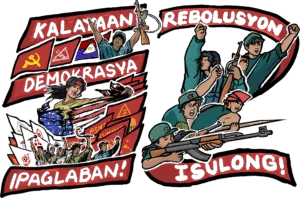The chronic and ever worsening crisis of the semicolonial and semifeudal system, which meant the intolerable oppression and exploitation of the people, engendered the people’s war even before the formal declaration of martial law. Upon the blatant rise of fascist tyranny, the people’s armed resistance expanded and intensified. The climate of fear and culture of silence spawned by the Marcos dictatorship gradually broke down as a broad array of oppressed classes and sectors dared to fight back and learned manifold ways to resist.
The Preparatory Commission of the National Democratic Front was formed in 1971, upon the initiative of the Communist Party of the Philippines. Seeking to provide a firm basis of unity for all popular forces forced underground by the martial law regime, the Preparatory Commission of the NDF issued a 10-point program on April 24, 1973, which would be acknowledged and celebrated as the founding day of the National Democratic Front. Thousands would eventually join the NDF through revolutionary mass organizations in various sectors.
Workers’ strikes, student boycotts, indoor and outdoor rallies, alternative newspapers and other forms of open protest became widespread, as support for the revolutionary armed struggle and the underground rapidly grew. Of particular significance was the active participation of church people in the protest movement through open and underground activities. All paved the way for the emergence of the gigantic mass actions in the 1983-86 period.
In the countryside, the revolutionary armed struggle spearheaded by the CPP and NPA blazed like a forest fire. From the mountainous areas and remote barrios, it steadily spread down to the plains, coastal towns and even some urban areas. Hand in hand with it were vigorous peasant mass struggles which won reductions in land rent and interest rates, increased wages for farm workers and higher prices for farm products. In the 80s, the tactical offensives of the NPA rose to a crescendo. District-size and province-size guerrilla fronts appeared. At their core were guerrilla bases where agrarian reform was implemented and organs of political power were established.
In the South, the Bangsa Moro organized their own armies and launched mass uprisings and armed rebellions against the dictatorship. The fascist regime launched attacks of genocidal proportions. The Moro armed struggle persisted. The Cordillera peoples staunchly resisted government schemes to dislodge them from their ancestral lands. They effectively prevented the implementation of the Chico River dam project and the expansion of Cellophil. The various peoples of the Cordillera joined in building an armed force and a revolutionary front to fight for self-determination, in unity with the entire national democratic movement. A revolutionary movement also developed among other indigenous peoples, especially the lumads of Mindanao.
The rapid deterioration of socio-economic conditions, the intensified contradictions among the reactionaries and the blows of people’s war from all quarters severely weakened the fascist dictatorship and forced it into blunders and desperate measures. The assassination of Ninoy Aquino on August 21, 1983 ignited a tremendous explosion of popular protest against the dictatorship. A broad anti-fascist movement came into being— from the toiling masses of workers and peasants to the middle social strata and onward to sections of the reactionary upper classes. It triggered a split in the regime’s most solid base of support, the military.
Marcos became a pariah in the international community. US policymakers were for a while divided on whether to continue full support or not for the dictatorship and then started to distance the US from its hated puppet and seek other alternatives. Ultimately, they decided to drop Marcos.
The armed and unarmed, legal and illegal struggles waged by the people reached a new level of strength. There was a combination of intensified armed offensives by NPA forces nationwide against squad- and platoon-size AFP patrols and detachments, widespread partisan operations in the urban areas and gigantic demonstrations, rallies, strikes and other mass protest actions.
The sudden plunge of the economy, the general upsurge of mass protest, the disaffection of most reactionaries and the withdrawal of US support from the Marcos regime came together in one historic conjuncture. A combined military rebellion and popular uprising finally overthrew the fascist dictatorship in February 1986. While the EDSA revolt had a popular character, the leadership was in the hands of a combination of forces dominated by pro-US reactionaries—the Aquino coalition of traditional politicians, the anti-Marcos sections of the fascist military, the conservative Church hierarchy and anti-Marcos big businessmen and landlords.
In the 1986 snap presidential elections, the boycott policy error had unduly sought to separate the advanced section of the masses from the main flow of the anti-fascist mass movement. More importantly, the revolutionary movement had been undermined and debilitated by the growing influence of the wrong line of military adventurism, urban insurrectionism, panic in the case of antiinfiltration campaigns in Mindanao and other places, and bureaucratism.
On the whole, the people’s war was still in the stage of the strategic defensive and the people’s army was small and weak compared to the enemy. The balance of forces between revolution and counterrevolution was still such that the outcome of the EDSA uprising could be decided by the U.S. and the local reactionaries. But beneath the celebration of the reactionaries over their removal of Marcos with relatively less damage, the splits within the reactionary Armed Forces of the Philippines further worsened. The grave crisis of the ruling system remained unsolved. And the widespread discontent of the people continued.
